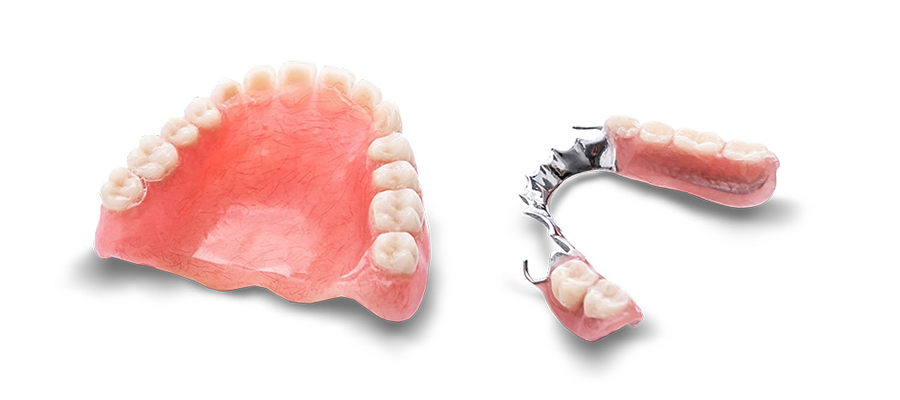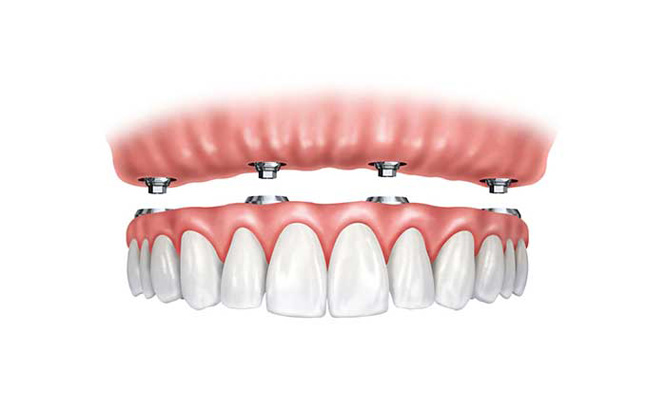Prosthetic Dental Treatments
Prosthetic dental treatments are a method of replacing teeth lost due to damage or discomfort in
the teeth or gums due to various reasons.
Dentures give you back what you have lost. Dental prostheses allow the dental tissues to remain healthy, gain an aesthetic appearance and fully fulfill the functions of the teeth.
Health, Aesthetics and Comfort
Today, dental prostheses can be applied to individuals of all ages, both men and women, and are aimed at restoring lost chewing function and restoring lost facial aesthetics. If you have lost one or more teeth, you know how significantly this affects your oral health, aesthetics and speech.
What are the Types of Dental Prosthesis?
Movable Prosthesis

Movable prosthesis is one of the methods used in the treatment of missing teeth that can be worn and removed by the users. Especially when there are no healthy teeth in the mouth, this type of prosthesis is mostly applied to patients over middle age. Movable dentures are also called prosthetic treatments provided with tooth and tissue support in the mouth.
What are the Types of Movable Prosthesis?
Movable dentures are appliances that replace missing teeth and can be worn and removed by the
patient. There are various types including total, partial, immediate and overdenture prostheses.
Total Dentures:
In cases where there are no natural teeth left in your mouth, these are prostheses made of acrylic, which are supported by the bone tissue remaining in the upper and lower jaw, and are also called ‘dentures’ among the people. It finds application in special cases where implants cannot be made.
Partial Dentures:
Partial dentures are removable prostheses that are applied in cases where some of the natural teeth are present and some of them have been extracted. Partial dentures are either made of acrylic or one-piece cast.
Immediatric Dentures:
In cases where all the main teeth need to be extracted, if the patient does not want to be toothless, prostheses called ‘immediate dentures’ can be made, which are inserted immediately as soon as the natural teeth are extracted. When the healing is complete and the tissues become incompatible with these prostheses, the patient’s permanent prostheses are started to be made.
Overdentures:
The prostheses that the dentist will make following some special preparations on a few natural teeth or roots in the mouth are called ‘overdentures’. The natural teeth or roots on which the prosthesis sits provide retention and stability to the prosthesis.
How to Care for Removable Prostheses?
Movable dentures should be cleaned with a soft brush after each meal, and the denture should be kept close to the sink to avoid any damage during washing. Keeping such dentures clean, which do not require cleaning with any toothpaste, allows them to be used in a healthy way for many years.
Such prostheses, which should be kept in water in a special container when not in use, cause discomfort by emitting bad odors over time if maintenance is disrupted.
Complete Denture Treatments

When there is no tooth to be supported in the mouth, it is called a completely tissue-supported prosthetic dental treatment applied by placing the retainer on the tissue surface of the prosthesis. This fixed crown is applied to the area where there is no tooth with the support of sensitive retainers.
Use of Complete Dentures
Palatal dentures are more difficult to use than other dentures because they are removable
dentures. They can be easily placed and removed from
the upper and lower jaw, but the comfort and chewing efficiency of fixed dentures are not expected. When first worn, some areas may develop bumps and wounds, after the bumps are removed, they become accustomed to use for a certain period of time and function like one’s own teeth.
Cleaning of Complete Dentures
Full dentures are cleaned under running water using soap and a brush. Toothpaste is not used for cleaning. Cleaning can be done with normal toothbrushes as well as special brushes for full dentures. In addition, some brands have cleaning tablets, the prosthesis can be cleaned by keeping the tablet in a glass of water.
Eating with full dental prostheses
The retention of prostheses made individually by taking measurements from the jaws depends on the amount of bone in the upper and lower jaw. If the amount of bone is sufficient, the retention and stabilization of the prosthesis will be good and food can be grinded easily with the prosthesis.
When a full denture is first fitted, there may be difficulty until the cheek and lip muscles get used
to it, after which biting, cutting and grinding functions can be performed comfortably. If the amount of bone in the upper and lower jaw is not sufficient, the retention and stabilization of the prosthetic teeth will be reduced and the prosthesis may move while eating. In this case, special adhesives can be used or support from implants placed in the jawbone may be required to prevent the dentures from moving.
Aesthetics in Full Dentures
Full dentures inflate cheek and lip depressions by filling them. The teeth used in prostheses can also be designed as porcelain in the front group. In this case, aesthetic satisfaction is high.
Points to Consider When Using
Care should be taken to clean complete dentures and cleaning should never be done with boiling water. When going to bed at night, the denture should be removed from the mouth and kept in a special container. In addition to these, it should be kept in mind that it is fragile in case of dropping it while putting it on and taking it off or cleaning it, and care should be taken.
Fixed Prostheses

The treatment model that is applied fixedly on the tooth with the impression taken on the teeth is
called fixed prostheses. Metal, ceramic and zirconium are used in the substructure of ceramic areas. With fixed prostheses;
Speech defects are eliminated,
The chewing function becomes easier.
The prosthesis supports the lips and cheeks. This provides significant gains in facial aesthetics.
Types of Fixed Prosthesis
Fixed prostheses, like other types of prostheses, are offered in different types according to the
patient’s needs, aesthetic expectations and economic status. Types of fixed prosthesis;
- Bridge Prostheses
- Full Metal Dentures
- Crown Prostheses
- Porcelain Dentures with Metal Base
- Porcelain Dentures with Zirconium Substructure
- Reinforced porcelain (Empress) Dentures
How to Clean Fixed Prostheses?
As with removable prostheses, continuous and regular maintenance is required to prolong the life of the prosthesis. If a crown and bridge prosthesis is applied to a patient with one or more missing teeth, careful use, maintenance and cleaning are mandatory to prolong the life of the prosthesis and the teeth under it.
No matter what material the prosthesis used in the mouth is made of, it is ultimately a foreign
material. For this reason, oral care should be emphasized to protect oral and dental health and to protect the teeth close to the crown and bridge. Fixed prosthesis care should be done by brushing 3 times a day, cleaning the gaps with the help of dental floss slowly and from the gums to the teeth.
Crown Veneer Prostheses
Crowns are applied in aesthetic cases for a single tooth. After the impression is taken, the mold is
transmitted to the technician and the technician is placed in place of the patient’s missing tooth by making applications that will provide aesthetics on the upper part with a durable substructure.
Bridge application, on the other hand, is called applications that will always remain in the mouth
by getting support from neighboring teeth in dental treatments with more than one missing tooth.
Laminate Porcelain Dentures
Laminated porcelain application is a treatment method applied in the gaps between the teeth in the color changes and shape changes in the front teeth. In this treatment, a small amount of abrasion is applied.
Implant Prostheses
Implant prostheses, one of the most preferred dental treatment models in recent years, are artificial tooth roots placed in the jawbone in the absence of one or more missing teeth. Since it is made of pure titanium, it is highly compatible with living tissues. Implants are divided into two as fixed and removable prostheses on implants.
Some Advice for Denture Wearers
To prevent the prosthesis from breaking, wash it in a container of water so that if you drop it, it will not break. Brush daily with a medium-hard brush. You can use toothpaste or soap, but rinse thoroughly before applying it to your mouth.
When you go to bed at night, you should take the dentures out of your mouth and put them in a container of water to allow the tissues in your mouth to come into contact with saliva and ventilate.
